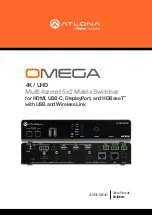
1-1
IF Diversity Switch Operator’s Guide
1
Section
400462-1
Rev. A
1 System Overview
1.1
Theory of Operation
The DS–2 IF Diversity Switch is designed to select the best of two 70 MHz IF signals based
upon AGC voltages applied to the A–D converter in U3 processor.
Table 1-1 on page 1-2
lists the decision points included in the processor program.
1.2
Power Supply Section
The unit is designed to operate using either –24 VDC, –48 VDC, or 100–240 VAC 50/60
Hz. depending on the model. For DC operated units, applied voltage range is –20 to –32
VDC or –38 to –52 VDC depending on the model. Two applied DC voltages (same range)
can be connected at P1 (D9 or D10) in the case of a hot standby system. Fuse F1 (1/2 amp)
mounted inside protects the circuit board and external connection. D9 and D10 also provide
reverse polarity protection. Primary power is converted to +5 V, +12 V, –12 V by U10 and
to Vref (5.0) by U7. The –8 V for control of U2, U11, U12 is through R3. D1 provides
visual indication of prime power.
1.3
Analog Buffer Amplifier
AGC voltage from the receiver is buffered by operational amplifier U9A, U8A. Resistors
R26, R25 provide an input termination to the amplifier. U9B, U8B act as inverters and
convert the negative going AGC to a positive input to U1. The output of each amplifier
passes through a RC filter to reduce noise on the analog input lines. Strapping points are
provided to allow for cases where the AGC voltage is positive going. Zener diodes D6 and
D5 protect U1 from voltages outside the U1 range.
1.4
IF Amplifier
70 MHz IF inputs are applied to J1 and J2. Parallel IF outputs are J3 and J4. U2, U11, U12
are GaAs monolithic switches controlled by opto–isolator ISO1, ISO2. When a control line
is –8 V, the switch passes the signal to the output. The network R8, C2 provides input
matching. The signal is split and applied through DC blocking capacitors C8 and C12 to
amplifiers U4 and U6. Gain and power of the amplifiers is determined by resistors R14, and
R18. Capacitors C7 and C10 couple the output to the matching network R13, C6 and R17,
C9.
1.5
Driver
The DS–2 switch provides visual and supervisory monitoring of its condition. U5 is a driver
for various outputs. LED’s are provided for front panel indication of POWER, AUTO,
MANUAL operation as well as the selected receiver A or B. Relays K1–K3 provide a
contact closure to indicate the active receiver of if the unit is in manual mode. The manual
relay is picked up for all conditions except manual mode and power off. If the manual mode
relay is closed and neither receiver select relay is active, a power failure has occurred.
1.6
Processor
U3 is a 8 bit micro–controller with built in A–D converter and on chip RAM/EPROM. R11










































